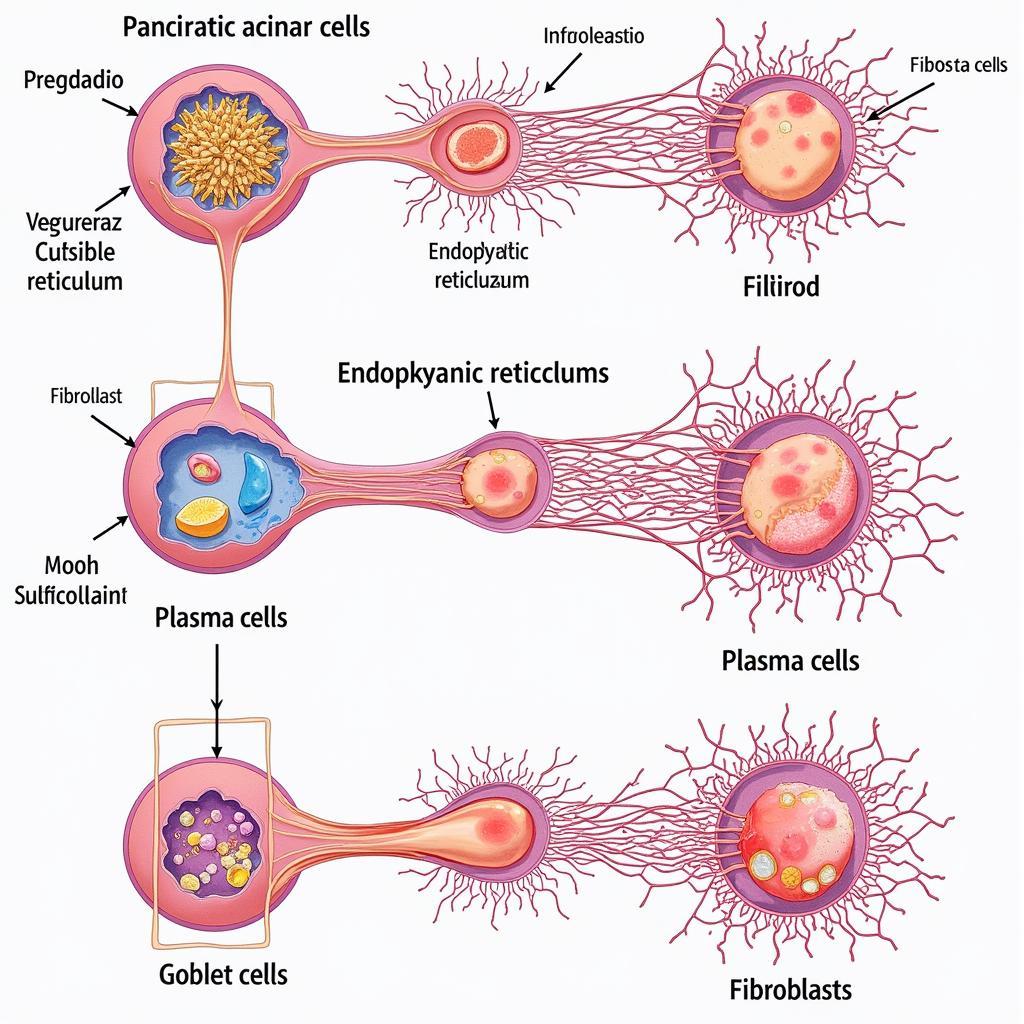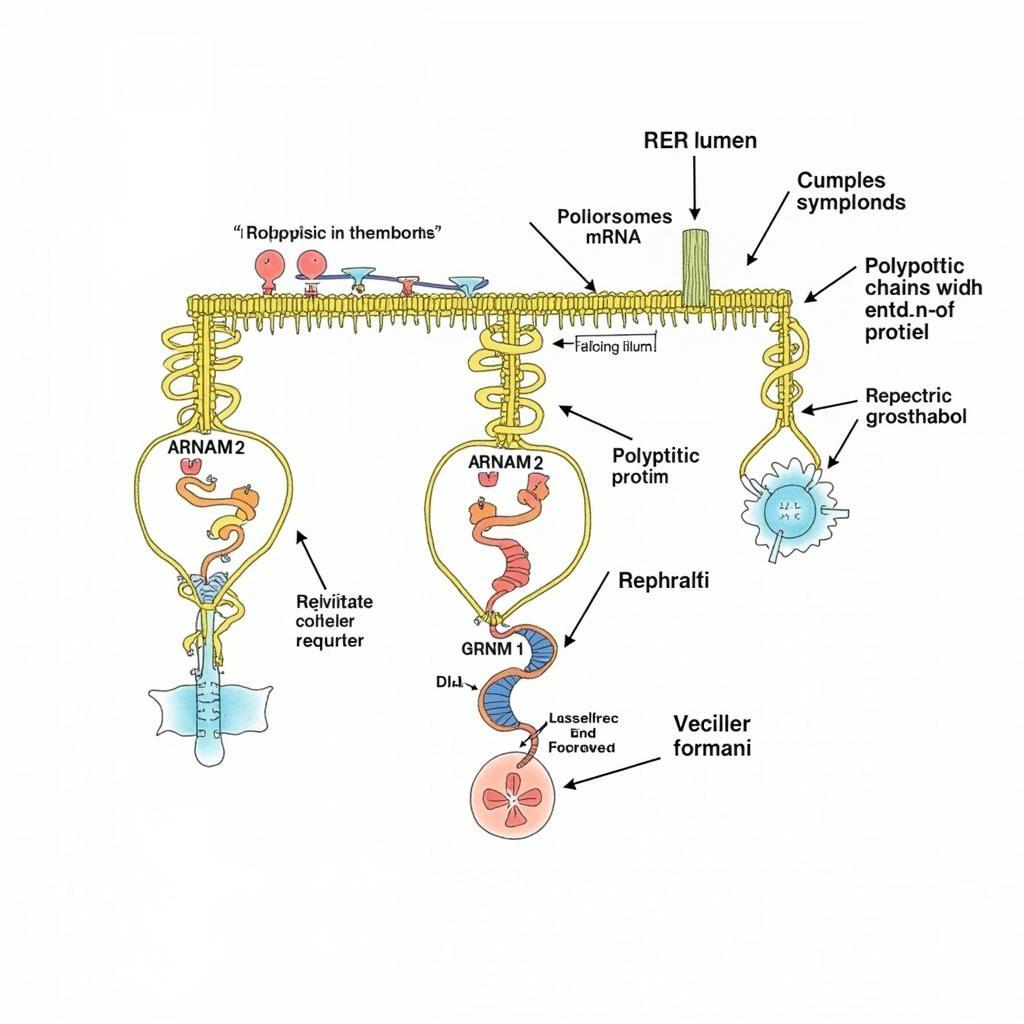The rough endoplasmic reticulum, or RER, is a crucial organelle found in eukaryotic cells, playing a vital role in protein synthesis and folding. Understanding where the rough endoplasmic reticulum is most developed gives us insights into the specialized functions of different cell types.
Understanding the Rough Endoplasmic Reticulum
The RER gets its “rough” appearance from the ribosomes studded on its surface. These ribosomes are the protein factories of the cell, translating genetic information into polypeptide chains. The RER membrane forms a network of interconnected sacs and tubules called cisternae, providing a large surface area for ribosomes to attach and carry out protein synthesis. The proteins synthesized by the RER are destined for various locations, including secretion outside the cell, insertion into cell membranes, or transport to other organelles.
Cell Types with Highly Developed RER
The rough endoplasmic reticulum is most prominent in cells specialized for protein secretion. These include:
- Pancreatic acinar cells: These cells produce and secrete digestive enzymes into the small intestine.
- Plasma cells (B lymphocytes): These cells are a crucial part of the immune system and produce antibodies.
- Goblet cells: These cells secrete mucus in the respiratory and digestive tracts.
- Fibroblasts: These cells synthesize and secrete collagen, a major component of connective tissue.
 Cells with Highly Developed RER
Cells with Highly Developed RER
Why is the RER Developed in These Cells?
The high development of RER in these cells directly correlates with their function. Their primary role involves synthesizing and secreting large amounts of proteins. The extensive RER network provides the necessary machinery and surface area for efficient protein production, folding, and transport.
How does the RER Contribute to Protein Secretion?
The RER plays a central role in protein secretion by:
- Providing a platform for ribosomes: Ribosomes attached to the RER synthesize proteins directly into the RER lumen.
- Facilitating protein folding: The RER lumen provides an environment for proteins to fold into their correct three-dimensional structures, often with the help of chaperone proteins.
- Modifying proteins: The RER can add carbohydrate chains (glycosylation) to proteins, which is important for their function and targeting.
- Transporting proteins: Newly synthesized proteins are packaged into vesicles and transported from the RER to the Golgi apparatus for further processing and sorting.
 RER and Protein Synthesis
RER and Protein Synthesis
The Role of the RER in Specialized Cell Functions
The highly developed RER is essential for the specialized functions of the cells mentioned earlier. For example, pancreatic acinar cells require an extensive RER to produce the large quantities of digestive enzymes needed for breaking down food. Similarly, plasma cells rely on their developed RER to synthesize and secrete antibodies, which are crucial for fighting infections.
What happens if the RER malfunctions?
Disruptions in RER function can lead to various diseases. Misfolded proteins can accumulate in the RER, causing stress and triggering cell death. This can contribute to conditions like cystic fibrosis and neurodegenerative diseases.
Conclusion
The rough endoplasmic reticulum is most developed in cells specializing in protein secretion, such as pancreatic acinar cells, plasma cells, goblet cells, and fibroblasts. This extensive network of RER is crucial for their ability to synthesize, fold, modify, and transport large quantities of proteins necessary for their specific functions. Understanding where the rough endoplasmic reticulum is most developed helps us appreciate the intricate workings of these specialized cells and their contribution to overall organismal health. If you’re looking for comfortable and reliable transportation in Hanoi, contact TRAVELCAR at 0372960696, email [email protected] or visit our office at 260 Cau Giay, Hanoi. We offer a range of vehicles including 16, 29 and 45 seaters for airport transfers, city tours and more.
FAQ
- What is the main function of the RER?
- Which cells have the most developed RER?
- How does the RER contribute to protein secretion?
- What are the consequences of RER malfunction?
- What is the difference between RER and smooth endoplasmic reticulum?
- Why is protein folding important?
- How does the RER interact with other organelles in the cell?
Do you have any other questions about the RER or Hanoi travel? Check out our other blog posts about Hanoi attractions and transportation services. Need a ride? Contact TRAVELCAR! Call us at 0372960696, email TRAVELCAR[email protected] or visit our office at 260 Cau Giay, Hanoi. Our 24/7 customer service team is ready to assist you.

